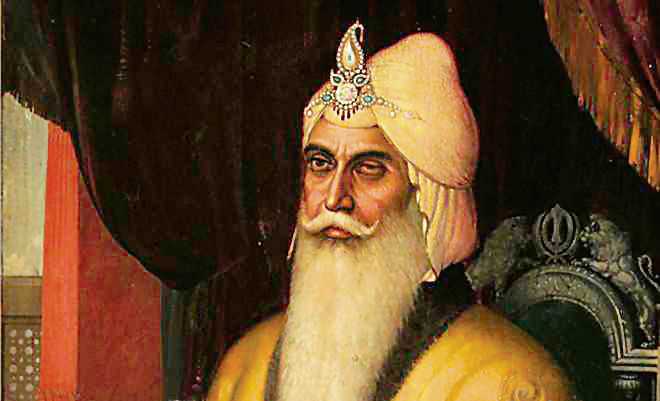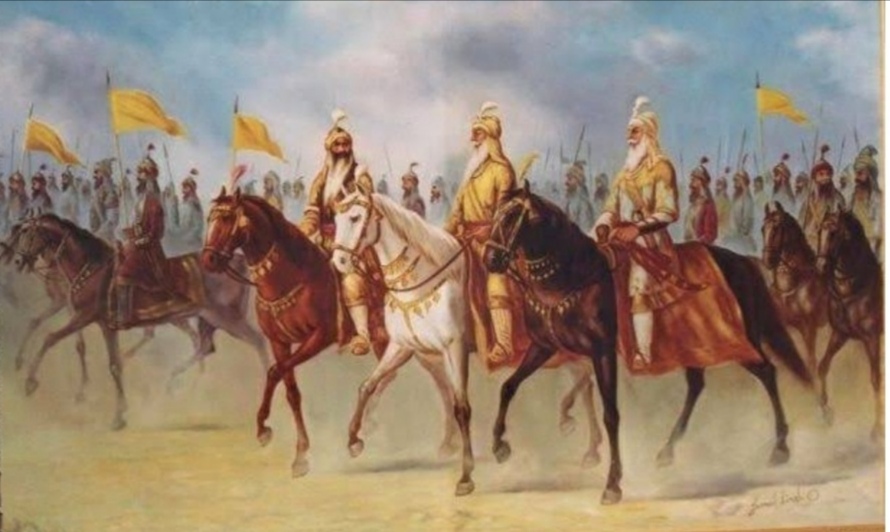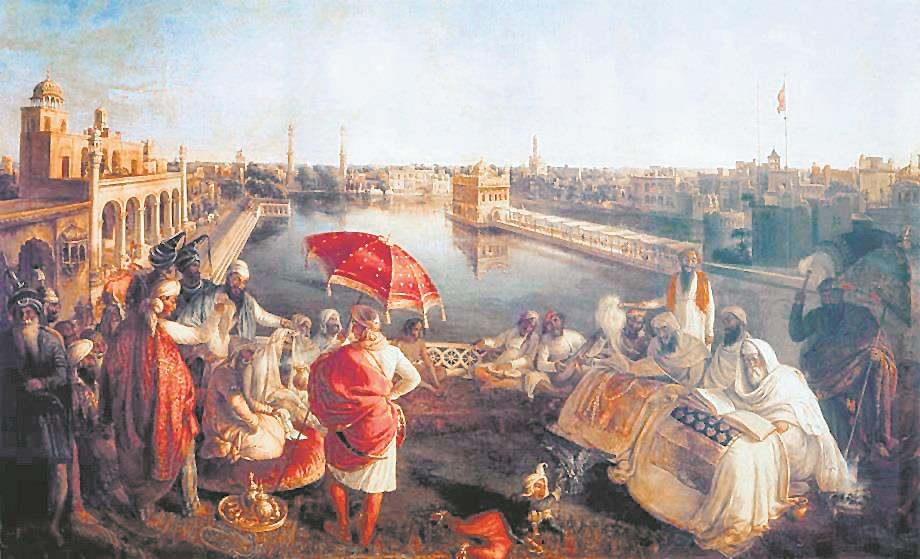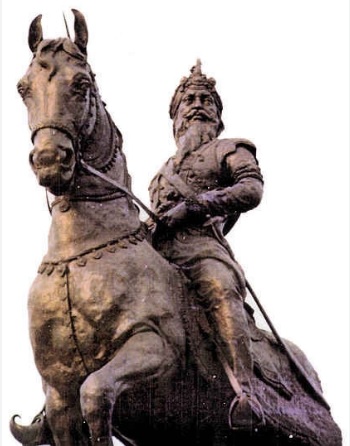ਮਹਾਂਬਲੀ ਰਣਜੀਤ ਸਿੰਘ ਹੋਇਆ ਪੈਦਾ,
ਨਾਲ ਜ਼ੋਰ ਦੇ ਮੁਲਕ ਹਿਲਾਇ ਗਿਆ।
Maharaja Ranjit Singh (2 November 1780 – 27 June 1839), popularly known as Sher-e-Punjab or "Lion of Punjab", was the first Maharaja of the Sikh Empire, which ruled the northwest Indian subcontinent in the early half of the 19th century. He survived smallpox in infancy but lost sight in his left eye. He fought his first battle alongside his father at age 10. After his father died, he fought several wars to expel the Afghans in his teenage years and was proclaimed as the "Maharaja of Punjab" at age 21. His empire grew in the Punjab region under his leadership through 1839.Maharaja Ranjit Singh a valiant warrior and a wise ruler of Punjab, popularly known as Sher-e-Punjab or the Lion of Punjab was respected as one of the most revered heroes in the Indian history. He was the first Maharaja of the Sikh Empire, which ruled the northwest Indian subcontinent in the early half of the 19th century.
 Sher-E-Punjab Maharaja Ranjit Singh
The first Indian in a millennium to turn the tide of invasion back into the homelands of India’s traditional conquerors, the Pashtuns (Afghans). His holdings stretched from the Khyber Pass in the northwest to the Sutlej River in the east, and from Kashmir, the Indian subcontinent’s northernmost area, southward to the Thar (Great Indian) Desert. Punjab state is the only state which has defeated Afghanistan.
Sher-E-Punjab Maharaja Ranjit Singh
The first Indian in a millennium to turn the tide of invasion back into the homelands of India’s traditional conquerors, the Pashtuns (Afghans). His holdings stretched from the Khyber Pass in the northwest to the Sutlej River in the east, and from Kashmir, the Indian subcontinent’s northernmost area, southward to the Thar (Great Indian) Desert. Punjab state is the only state which has defeated Afghanistan.
Education was especially encouraged in Punjab during the ruling of Maharaja Ranjit Singh. Both men and women were inspired to take up education in their childhood and there were village schools, which offered education in basic local language, math and science. Compared to rest of India, Punjabis were reasonably well educated and there were less social evils and superstition in Punjab as compared to other parts of the sub-continent.
Prior to his rise, the Punjab region had numerous warring misls (confederacies), twelve of which were under Sikh rulers and one Muslim. Maharaja Ranjit Singh successfully absorbed and united the Sikh misls and took over other local kingdoms to create the Sikh Empire. He repeatedly defeated invasions by outside armies, particularly those arriving from Afghanistan, and established friendly relations with the British.
Maharaja Ranjit Singh's reign introduced reforms, modernisation, investment into infrastructure and general prosperity. His Khalsa army and government included Sikhs, Hindus, Muslims and Europeans. His legacy includes a period of Sikh cultural and artistic renaissance, including the rebuilding of the Harmandir Sahib in Amritsar as well as other major gurudwaras, including Takht Sri Patna Sahib, Bihar and Hazur Sahib Nanded, Maharashtra under his sponsorship
As per the historian Matthew Lockwood, Maharaja Ranjit Singh established his reign Afghan raids, chronic infighting among Punjab’s various misls (sovereign states) and the looming presence of British expansion left the region politically fragile, economically weak and religiously splintered. All this changed with the rise of Singh, the Lion of Punjab’. Matthew Lockwood acknowledged Maharaja Ranjit Singh's efforts to modernising the Sikh Khalsa Army, embracing western innovations without abandoning local forms and institutions, unifying the fractious misls, stabilising the frontier with Afghanistan, and reaching a mutually beneficial detente with the British East India Company. Maharaja Ranjit Singh is also known for restoring Sikh gurudwaras, including Golden Temple in Amritsar, as well as creating an atmosphere of religious tolerance for all communities.
Governance

Maharaja Ranjit Singh allowed men from different religions and races to serve in his army and his government in various positions of authority. His army included a few Europeans, such as the Frenchman Jean-Francois Allard, though Singh maintained a policy of refraining from recruiting Britons into his service, aware of British designs on the Indian subcontinent. Despite his recruitment policies, he did maintain a diplomatic channel with the British; in 1828, he sent gifts to George IV and in 1831, he sent a mission to Simla to confer with the British Governor General, William Bentinck, while in 1838, he cooperated with them in removing the hostile Islamic Sultan in Afghanistan.
Inspirational Leadership Qualities
Visionary outlook
 When a manager is put in a position of authority, he may be needed to lead the organization during a
time of transition. Vision plays a very important role in managing change. If the leadership of an organization
understands the vital role vision plays in managing change, the organization will be more likely to undergo
transition successfully. Ranjit Singh‟s vision of a united Sikh empire & the courage to take initiative in that
direction can be used by business schools to understand the various nuances in effective leadership.
When a manager is put in a position of authority, he may be needed to lead the organization during a
time of transition. Vision plays a very important role in managing change. If the leadership of an organization
understands the vital role vision plays in managing change, the organization will be more likely to undergo
transition successfully. Ranjit Singh‟s vision of a united Sikh empire & the courage to take initiative in that
direction can be used by business schools to understand the various nuances in effective leadership.
Realistic
In today‟s corporate world, one needs to go where no one has gone. Until Ranjit Singh marched into
Lahore and made it a Sikh territory, it was considered beyond the reach of any Sikh. He had a vision of what
could be, and he made that vision a reality. Henry Ford had a vision, so did Walt Disney, Steve Jobs, Bill
Bowerman, and Branson. They all focused on creating and building, not just on learning.
Intelligence
Sometimes, the difference between effectiveness and failure lies in how skillfully a tool is used. Better and superior doesn’t guarantee success. Maharaja Ranjit Singh’s intelligence and smart moves has been the reason behind his success. Intelligence can turn an apparent disadvantage into a win. A well trained worker with a simple tool can be much more effective than a less well trained operator with an expensive, more impressive tool.
Self-Confidence
 The dynamic business world today has no shortage of problematic circumstances where a manager will need to take strong decisions which don’t comply with the regular stance. Managers today can take inspiration from the manner Maharaja Ranjit Singh tackled situations with confidence & appealing communication skills.
The dynamic business world today has no shortage of problematic circumstances where a manager will need to take strong decisions which don’t comply with the regular stance. Managers today can take inspiration from the manner Maharaja Ranjit Singh tackled situations with confidence & appealing communication skills.
BBC Polling
Maharaja Ranjit Singh, the 19th century ruler of the Sikh Empire in India, has beaten competition from around the world to be named the "Greatest Leader of All Time" in a poll conducted by ‘BBC World Histories Magazine'. BBC World Histories Magazine had asked its readers to vote for the greatest leader from the names nominated by several renowned historians. The readers were asked to choose a leader who "exercised power and had a positive impact on humanity and to explore their achievements and legacy".
Over 5,000 readers voted in the poll. Polling more than 38 per cent of the vote, Singh was praised for creating a new tolerant empire. Maharaja Ranjit Singh, the founder and ruler of Sikh empire during the early 19th century, has defeated Winston Churchill and Abraham Lincoln to be voted as the greatest leader of all times. The second place went to African independence fighter Amilcar Cabral who is credited with uniting over a million Guineans to free themselves from Portuguese occupation. He is also credited for inspiring many other colonised African countries to rise and fight for independence. Amilcar Cabral was voted the greatest leader by 25 per cent readers.British prime minister Winston Churchill is in the third position with 7 per cent of the vote for his contributions to Britain during world war. American president Abraham Lincoln was voted fourth.
BBC World Histories Magazine had asked its readers to vote for the greatest leader from the names nominated by several renowned historians. The readers were asked to choose a leader who "exercised power and had a positive impact on humanity and to explore their achievements and legacy".
Taking more than 38 per cent of the vote, Maharaja Ranjit Singh was described by nominating historian Matthew Lockwood as a modernising and uniting force, whose reign "marked a golden age for Punjab and northwest India".
18 facts about Maharaja Ranjit Singh
- He was born on November 13, 1780 and passed away on June 27, 1839.
- Ranjit Singh first fought in a battle when he was only 10 years old, and at the age of 17, he failed the king of Afghanistan Zaman Shah Durrani's invasion of India.
- Zaman Shah Durrani was yet again defeated by Ranjit Singh in the Battle of Amritsar (1797), the Battle of Gujarat in the same year and the Battle of Amritsar the next year.
- As a child, Singh suffered from smallpox which resulted in him losing one of his eyes.
- Ranjit captured Lahore in the year 1799, which is also considered as the turning point for the Sikh Empire.
- He was crowned Maharaja in 1801 only at the age of 20.
- Ranjit Singh had eight sons, but he acknowledged only Kharak Singh and Duleep Singh as his biological sons.
- Singh started drinking at a very young age as drinking alcohol was considered to be a matter of pride at the time.
- He had 20 wives. Notables were Rani Mahtab Kaur, Rani Raj Kaur, Ranji Ratan Kaur, Rani Daya Kaur, and Maharani Jind Kaur.
- The Sikh Empire, now known as Punjab, was a region spanning the border into modern-day People's Republic of China and Islamic Republic of Afghanistan.
- Under his tenure, the Sikh Empire was very secular since it allowed men from different religions as well, to rise to commanding positions of authority.
- His army even included a few Europeans. However, the British were not allowed to join it as it was believed that they have a very inconsistent nature.
- In his empire, none of the subjects were discriminated on account of their religion. He never forced Sikhism on non-Sikhs and respected all religions.
- The golden part of the Golden Temple and even some of the intricate marble work was done under the aid of Maharaja Ranjit Singh.
- The Sikh army was defeated in the first Anglo-Sikh War and under the terms of the Treaty of Lahore and the Treaty of Bhyroval, all major decisions were made by the British East India Company.
- Maharaja Ranjit Singh is remembered for the possession of the Koh-i-Noor diamond which he left to Jagannath Temple in Odisha and was given to him by Shuja Shah Durrani of Afghanistan.
- In 2003, a 22-feet tall bronze statue of Singh was installed in the Parliament of India in his honour. Not only in India but in a French town called Saint Tropez, that had military links with Punjab, installed a bronze bust of Ranjit Singh in 2016 -- and Maharaja is revered worldwide.
- A museum in Amritsar and a university in Punjab also mark Ranjit Singh's undying legacy.
Sikh Military History Forum
Click on the link below
Sikh Military History Forum
Legacy
In today’s ultra-competitive business sphere, managers are stressed to position all the weapons in their stashes to stay forward of the opposition and win the day. The necessity to tap the knowledge and understanding of some of history’s paramount leaders is more today than ever before. Maharaja Ranjit Singh may be long gone, but his accomplishments still stand. There is a lot that businesses today can absorb from the military leadership of today & especially from the past.
Celebration of Birth Anniversary of Maharaja Ranjit Singh
Speech of Dr. Sumail Singh Sidhu
Central University of Punjab, Bathinda.
Click on the link below
Lecture on Birth Anniversay of Maharaja Ranjit Singh
, ,
Prof. (Dr.) Jasbir Singh Hundal
Campus Director